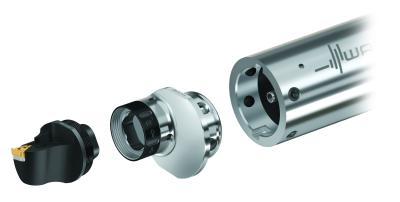
Walter has expanded its Accure-tec anti-vibration boring bar line with the addition of the A3001 boring bar in combination with A2201 intermediate offset adaptor for larger diameter bores.
The standard A2201 is an offset adaptor for reduced radial forces, greater stability and provides more space between the boring bar and the bore wall for improved chip removal with very deep bores. With the A3001 and the A2201 Walter has increased boring bar diameters to 2.5-4-in. and 60-100 mm. Unlike conventional steel or solid carbide boring bars that are often ineffective at length/diameter ratios beyond 6 x Dc, the Accure∙tec A3001, with its patented vibration dampening system, excels at length/diameter ratios beyond 6 x D up to 10 x D -- well past the point where conventional steel or solid carbide boring bars often prove less efficient.
Of prime importance is the fact that users of the Accure∙tec A3001 or A3000 boring bars will not have to worry about time-consuming "fine tuning" of the dampening function, as its patented anti-vibration feature is preset at the factory, so the tool is ready for quick application. The new tool is available with both negative and positive inserts.
With the A3001 Walter offers Capto C6, C8, and HSK-T 100 connections, and the compact, robust QuadFit precision (± 0.002 mm) quick-change exchangeable heads that decrease downtime and boost versatility. Together with the A2201's larger offset dimensions, the internal coolant delivery of the A3001 boring bar ensures optimum chip removal, adding to its superior surface finishes. It provides for fast and productive counterboring and internal profiling of parts in industries such as aerospace, oil and gas, and general metalworking. This product addition enhances the already existing product line of A3000 anti-vibration boring bars, which do not require the A2201 intermediate adaptors, and cover the diameter range of 1-2 in. and 25-50mm; and are also offered in Capto C4, C8 and HSK-T 63-100.
Contact Details
Related Glossary Terms
- boring
boring
Enlarging a hole that already has been drilled or cored. Generally, it is an operation of truing the previously drilled hole with a single-point, lathe-type tool. Boring is essentially internal turning, in that usually a single-point cutting tool forms the internal shape. Some tools are available with two cutting edges to balance cutting forces.
- boring bar
boring bar
Essentially a cantilever beam that holds one or more cutting tools in position during a boring operation. Can be held stationary and moved axially while the workpiece revolves around it, or revolved and moved axially while the workpiece is held stationary, or a combination of these actions. Installed on milling, drilling and boring machines, as well as lathes and machining centers.
- coolant
coolant
Fluid that reduces temperature buildup at the tool/workpiece interface during machining. Normally takes the form of a liquid such as soluble or chemical mixtures (semisynthetic, synthetic) but can be pressurized air or other gas. Because of water’s ability to absorb great quantities of heat, it is widely used as a coolant and vehicle for various cutting compounds, with the water-to-compound ratio varying with the machining task. See cutting fluid; semisynthetic cutting fluid; soluble-oil cutting fluid; synthetic cutting fluid.
- counterboring
counterboring
Enlarging one end of a drilled hole. The enlarged hole, which is concentric with the original hole, is flat on the bottom. Counterboring is used primarily to set bolt heads and nuts below the workpiece surface.
- metalworking
metalworking
Any manufacturing process in which metal is processed or machined such that the workpiece is given a new shape. Broadly defined, the term includes processes such as design and layout, heat-treating, material handling and inspection.
- profiling
profiling
Machining vertical edges of workpieces having irregular contours; normally performed with an endmill in a vertical spindle on a milling machine or with a profiler, following a pattern. See mill, milling machine.







